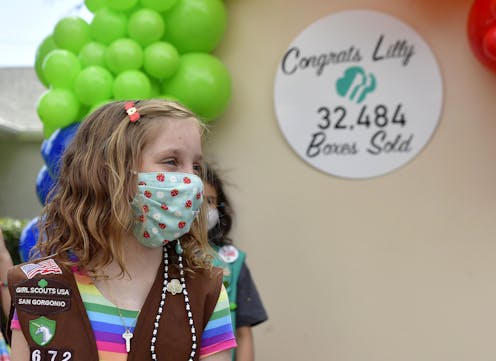Less than 2% of all US giving supports women's and girls' charities
- Written by Tessa Skidmore, Research Associate of Philanthropy, Women's Philanthropy Institute; Doctoral student of Philanthropy, IUPUI
 CC BY-ND[1]
The #MeToo movement[2] gained traction in late 2017 and continued to grow the following year[3], as countless women shared their experiences with sexual harassment, abuse and assault. But donations to women’s and girls’ organizations made up just 1.92% of all charitable giving in 2018, the most recent data available.
That burst of increased public attention, according to the latest edition of the Women & Girls Index[4], did little in terms of the dollars contributed to causes serving women and girls. The share of donor funds going to those groups had stood at 1.8% in 2017 before inching higher the following year.
We are[5] three of the researchers[6] who produce[7] this index. To measure U.S. charitable giving to women’s and girls’ organizations, we sift through Internal Revenue Service data on nonprofit organizations.
To be sure, philanthropic support for women’s and girls’ organizations did grow a little in 2018, reaching $8.2 billion. This was the highest level recorded since 2012, which is as far back as our data goes.
The index measures donations to many kinds of organizations, running the gamut from Susan G. Komen[8], which fights breast cancer, to women’s colleges[9] like Smith and Scripps, to the Girl Scouts[10].
Anyone may download or search the data[11] for free by visiting our website.
Some kinds of women’s and girls’ groups registered bigger gains than others in 2018. Those focused on the environment, such as Women’s Voices for the Earth[12] and Women of Renewable Industries and Sustainable Energy[13], saw their donations grow by 37.1%. Charities focused on civil rights and advocacy, including the National Women’s Law Center[14] and Catalyst[15] grew 32.3%.
While these categories make up a small share of all giving to women’s and girls’ organizations, their sharp gains suggest that the #MeToo movement[16] and growing awareness about the inequitable impacts[17] of climate change are boosting support for related causes.
In the future, we’d like to see what’s happening with intersectional philanthropy[18]. Examples of what we hope to study include giving for women and girls of color[19], women and girls with disabilities and LGBTQ women and girls.
[Over 110,000 readers rely on The Conversation’s newsletter to understand the world. Sign up today[20].]
References^ CC BY-ND (creativecommons.org)^ #MeToo movement (metoomvmt.org)^ continued to grow the following year (theconversation.com)^ Women & Girls Index (philanthropy.iupui.edu)^ We are (scholar.google.com)^ researchers (scholar.google.com)^ produce (scholar.google.com)^ Susan G. Komen (www.komen.org)^ women’s colleges (www.womenscolleges.org)^ Girl Scouts (www.girlscouts.org)^ may download or search the data (wgi.communityplatform.us)^ Women’s Voices for the Earth (www.womensvoices.org)^ Women of Renewable Industries and Sustainable Energy (wrisenergy.org)^ National Women’s Law Center (nwlc.org)^ Catalyst (www.catalyst.org)^ #MeToo movement (www.reuters.com)^ inequitable impacts (www.un.org)^ intersectional philanthropy (philanthropywomen.org)^ women and girls of color (forwomen.org)^ Sign up today (theconversation.com)Authors: Tessa Skidmore, Research Associate of Philanthropy, Women's Philanthropy Institute; Doctoral student of Philanthropy, IUPUI
CC BY-ND[1]
The #MeToo movement[2] gained traction in late 2017 and continued to grow the following year[3], as countless women shared their experiences with sexual harassment, abuse and assault. But donations to women’s and girls’ organizations made up just 1.92% of all charitable giving in 2018, the most recent data available.
That burst of increased public attention, according to the latest edition of the Women & Girls Index[4], did little in terms of the dollars contributed to causes serving women and girls. The share of donor funds going to those groups had stood at 1.8% in 2017 before inching higher the following year.
We are[5] three of the researchers[6] who produce[7] this index. To measure U.S. charitable giving to women’s and girls’ organizations, we sift through Internal Revenue Service data on nonprofit organizations.
To be sure, philanthropic support for women’s and girls’ organizations did grow a little in 2018, reaching $8.2 billion. This was the highest level recorded since 2012, which is as far back as our data goes.
The index measures donations to many kinds of organizations, running the gamut from Susan G. Komen[8], which fights breast cancer, to women’s colleges[9] like Smith and Scripps, to the Girl Scouts[10].
Anyone may download or search the data[11] for free by visiting our website.
Some kinds of women’s and girls’ groups registered bigger gains than others in 2018. Those focused on the environment, such as Women’s Voices for the Earth[12] and Women of Renewable Industries and Sustainable Energy[13], saw their donations grow by 37.1%. Charities focused on civil rights and advocacy, including the National Women’s Law Center[14] and Catalyst[15] grew 32.3%.
While these categories make up a small share of all giving to women’s and girls’ organizations, their sharp gains suggest that the #MeToo movement[16] and growing awareness about the inequitable impacts[17] of climate change are boosting support for related causes.
In the future, we’d like to see what’s happening with intersectional philanthropy[18]. Examples of what we hope to study include giving for women and girls of color[19], women and girls with disabilities and LGBTQ women and girls.
[Over 110,000 readers rely on The Conversation’s newsletter to understand the world. Sign up today[20].]
References^ CC BY-ND (creativecommons.org)^ #MeToo movement (metoomvmt.org)^ continued to grow the following year (theconversation.com)^ Women & Girls Index (philanthropy.iupui.edu)^ We are (scholar.google.com)^ researchers (scholar.google.com)^ produce (scholar.google.com)^ Susan G. Komen (www.komen.org)^ women’s colleges (www.womenscolleges.org)^ Girl Scouts (www.girlscouts.org)^ may download or search the data (wgi.communityplatform.us)^ Women’s Voices for the Earth (www.womensvoices.org)^ Women of Renewable Industries and Sustainable Energy (wrisenergy.org)^ National Women’s Law Center (nwlc.org)^ Catalyst (www.catalyst.org)^ #MeToo movement (www.reuters.com)^ inequitable impacts (www.un.org)^ intersectional philanthropy (philanthropywomen.org)^ women and girls of color (forwomen.org)^ Sign up today (theconversation.com)Authors: Tessa Skidmore, Research Associate of Philanthropy, Women's Philanthropy Institute; Doctoral student of Philanthropy, IUPUIRead more https://theconversation.com/less-than-2-of-all-us-giving-supports-womens-and-girls-charities-170430

